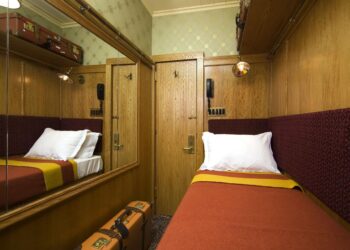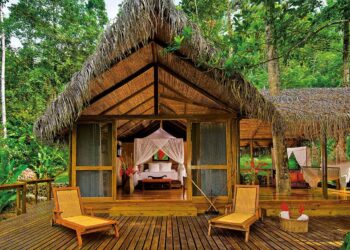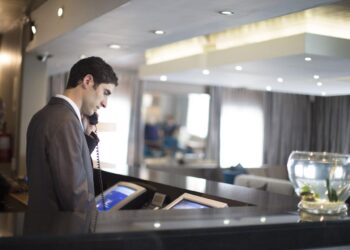There’s an undeniable magic to the mountains – a majestic allure that calls to adventurers, solace-seekers, and nature lovers alike. Nestled amidst towering peaks, whispering forests, and pristine alpine lakes, mountain lodges offer more than just accommodation; they provide an immersive escape into the heart of wilderness, blending rustic charm with refined comfort. These unique properties serve as gateways to thrilling outdoor pursuits in summer and enchanting winter wonderland experiences. For those yearning to breathe crisp, clean air, wake to panoramic vistas, and connect deeply with the natural world, a mountain lodge promises a transformative retreat. This comprehensive article will delve into what defines these captivating alpine havens, the diverse experiences they offer, their crucial role in sustainable tourism, and how they continue to evolve to meet the desires of modern mountain enthusiasts.
The Characteristics of an Authentic Mountain Lodge

A true mountain lodge is distinguished by its seamless integration with the natural environment, offering warmth, tranquility, and a spirit of adventure.
A. Harmonious Integration with Natural Surroundings
The most fundamental aspect of a mountain lodge is its harmonious integration with its natural surroundings. This isn’t just about being located in the mountains; it’s about being built in a way that respects and celebrates the landscape.
A. Indigenous Materials: Lodges often utilize local stone, reclaimed timber, and other sustainable materials that blend seamlessly with the natural palette of the mountains, reflecting regional architectural styles.
B. Panoramic Views: Guest rooms, common areas, and dining spaces are typically designed to maximize breathtaking views of peaks, valleys, forests, or alpine lakes, making the majestic scenery an integral part of the indoor experience.
C. Minimized Environmental Impact: Responsible lodges prioritize building practices that minimize disruption to local ecosystems, often employing techniques like sensitive site placement and erosion control.
D. Connection to Nature: Large windows, outdoor decks, and direct trail access blur the lines between indoors and outdoors, constantly reminding guests of their wild surroundings.
This deep respect for nature imbues the lodge with a unique sense of place and tranquility.
B. Rustic Charm Meets Refined Comfort
Mountain lodges master the art of blending rustic charm with refined comfort. They offer a cozy, authentic ambiance without compromising on luxury or modern conveniences.
A. Warm and Inviting Interiors: Common areas often feature roaring fireplaces, exposed wooden beams, plush furnishings, and local craftsmanship, creating a welcoming and intimate atmosphere.
B. Comfortable Accommodations: Rooms typically offer comfortable bedding, modern bathrooms, and amenities that cater to post-adventure relaxation, such as deep soaking tubs or spacious showers.
C. Personalized Service: Due to their often smaller, more intimate scale, lodges can provide highly personalized service, with staff who are knowledgeable about local activities and genuinely attentive to guest needs.
D. Authentic Decor: Decorations often include local art, historical artifacts, or nature-inspired elements that tell the story of the region and its mountain culture.
This balance ensures guests feel both deeply connected to the wilderness and comfortably pampered.
C. Gateway to Outdoor Adventures
Mountain lodges serve as ideal gateways to a myriad of outdoor adventures, catering to enthusiasts across all seasons.
A. Winter Sports: In colder months, lodges provide unparalleled access to skiing, snowboarding, snowshoeing, cross-country skiing, and ice climbing. Many offer ski-in/ski-out access, equipment rentals, and lessons.
B. Summer Activities: During warmer seasons, guests can enjoy hiking, mountain biking, rock climbing, whitewater rafting, fishing, and wildlife viewing. Lodges often provide guided tours or trail maps.
C. Guided Expeditions: Many lodges offer or arrange guided expeditions for more challenging pursuits, such as mountaineering, heli-skiing, or multi-day treks, led by experienced local guides.
D. On-Site Activity Centers: Dedicated centers for booking excursions, renting gear, or getting expert advice on local trails and conditions, making it easy for guests to plan their adventures.
The proximity and direct access to nature’s playground are a primary draw for guests.
D. Specialized Wellness and Relaxation Facilities
After a day of adventure, mountain lodges offer specialized wellness and relaxation facilities designed to soothe tired bodies and rejuvenate the spirit.
A. Spa and Wellness Centers: Often featuring saunas, steam rooms, hot tubs (indoor and outdoor, sometimes with mountain views), and a range of massage and therapeutic treatments.
B. Heated Pools: Both indoor and outdoor heated pools, often with stunning views, provide year-round opportunities for swimming and relaxation.
C. Yoga and Meditation Spaces: Dedicated areas for mindfulness practices, sometimes offering classes led by resident instructors, leveraging the serene mountain ambiance.
D. Fireplaces and Reading Nooks: Cozy spots perfect for unwinding with a book, enjoying a warm drink, and reflecting on the day’s experiences.
The emphasis is on recovery and inner peace, complementing the active pursuits.
E. Hearty, Locally-Inspired Cuisine
Dining at a mountain lodge is often a highlight, characterized by hearty, locally-inspired cuisine that reflects regional flavors and provides nourishment for active days.
A. Farm-to-Table Focus: Many lodges prioritize sourcing ingredients from local farms, dairies, and producers, ensuring freshness and supporting the community.
B. Robust Breakfasts: Fueling guests for their mountain adventures with substantial breakfast buffets or à la carte options.
C. Comfort Food with a Twist: Offering elevated versions of traditional mountain fare, like stews, grilled meats, fresh fish from local rivers, and artisanal cheeses.
D. Alpine-Inspired Beverages: Featuring local craft beers, regional wines, and warm beverages perfect for chilly evenings.
E. Cozy Dining Ambiance: Restaurants often feature rustic decor, fireplaces, and panoramic windows, creating a warm and inviting atmosphere for meals.
The culinary experience enhances the sense of place and provides essential energy.
The Evolution of Mountain Lodges

The mountain lodge sector is continually evolving, driven by changing traveler preferences, technological integration, and a growing commitment to environmental stewardship.
A. From Rustic Cabins to Luxury Retreats
The perception and offerings of mountain lodges have diversified significantly. What might have once been rudimentary “rustic cabins” have transformed into sophisticated luxury retreats, offering five-star amenities and services. This evolution caters to a broader market, from adventurous backpackers to discerning travelers seeking high-end comfort amidst nature. The range now includes everything from charming, simple guesthouses to ultra-luxury chalets with private chefs.
B. Emphasis on Year-Round Appeal
Historically, mountain lodges were largely seasonal, bustling during winter ski seasons or summer hiking periods. However, a growing trend sees them focusing on year-round appeal. This involves:
A. Diversified Activities: Promoting shoulder-season activities like fall foliage tours, spring wildflower hikes, or dedicated wellness retreats.
B. Indoor Amenities: Investing in robust indoor facilities like comprehensive spas, indoor pools, and diverse dining options to remain attractive regardless of weather.
C. Event Hosting: Marketing themselves as venues for weddings, corporate retreats, and special events during traditionally quieter periods, ensuring consistent revenue streams.
This strategic shift optimizes resource utilization and caters to varied traveler motivations.
C. Sustainability and Eco-Conscious Operations
Given their direct interaction with fragile ecosystems, sustainability and eco-conscious operations are becoming paramount for mountain lodges.
A. Renewable Energy: Utilizing solar panels, micro-hydro systems, or geothermal heating to reduce reliance on fossil fuels.
B. Waste Management: Implementing robust recycling, composting, and waste reduction programs, minimizing landfill contributions.
C. Water Conservation: Using low-flow fixtures, rainwater harvesting, and efficient landscaping to minimize water usage.
D. Protecting Biodiversity: Engaging in local conservation efforts, supporting wildlife protection, and educating guests on responsible interaction with nature.
E. Local Sourcing: Prioritizing local produce, sustainable building materials, and supporting regional artisans to reduce carbon footprint and bolster the local economy.
These efforts demonstrate a deep commitment to preserving the natural beauty that guests come to experience.
D. Technology for Seamless Guest Experiences
While emphasizing nature, modern mountain lodges strategically employ technology for seamless guest experiences without detracting from the rustic charm.
A. Online Booking and Mobile Apps: For easy reservations, digital check-ins, and access to lodge information and activity schedules.
B. Smart Room Controls: Allowing guests to manage lighting and heating efficiently, often with energy-saving modes.
C. High-Speed Wi-Fi: Essential for guests needing to stay connected or work remotely, even in remote locations.
D. Digital Concierge: Providing instant access to trail maps, weather forecasts, activity bookings, and local recommendations.
E. Sustainable Tech: Using smart thermostats or energy management systems that optimize energy consumption based on occupancy.
Technology enhances convenience, allowing guests to focus on their mountain adventure.
E. Wellness and Retreat Focus
The serene environment of mountains naturally lends itself to wellness and retreat offerings. Many lodges are expanding their focus beyond adventure to include:
A. Dedicated Yoga and Meditation Spaces: Often with views, for individual or guided practices.
B. Specialized Detox and Cleansing Programs: Leveraging the clean air and natural ingredients.
C. Mindfulness and Nature Immersion Workshops: Connecting guests with the healing power of the natural environment.
D. Healthy, Organic Cuisine: Emphasizing wholesome, nutritious meals that support well-being.
This caters to a growing desire for holistic rejuvenation in a peaceful setting.
The Economic and Societal Impact of Mountain Lodges
Mountain lodges are crucial economic drivers and play a significant role in the development and preservation of often remote alpine regions.
A. Economic Growth for Remote Communities
In many cases, mountain lodges are the primary economic drivers for often remote communities. They:
A. Create Jobs: Providing employment across various sectors, including hospitality, culinary arts, guiding, and maintenance, often in areas with limited alternative opportunities.
B. Generate Revenue: Through accommodation, dining, activity bookings, and retail, contributing significantly to local economies and tax bases.
C. Attract Investment: Encouraging further development in tourism-related infrastructure and services in the region.
This economic lifeline can be vital for the survival and prosperity of small mountain towns.
B. Promoting Sustainable Tourism and Conservation
By their very nature, responsible mountain lodges are instrumental in promoting sustainable tourism and conservation. Their existence relies on a pristine environment, incentivizing:
A. Environmental Protection: Funding and participating in conservation efforts for forests, wildlife, and water sources.
B. Responsible Visitor Practices: Educating guests on Leave No Trace principles and respectful interaction with nature.
C. Support for National Parks/Protected Areas: Often located near or within protected areas, they can act as advocates and partners in their preservation.
This makes them key players in protecting the natural assets that draw visitors.
C. Preserving Local Culture and Traditions
Many mountain lodges actively engage in preserving local culture and traditions. This includes:
A. Hiring Local Staff: Ensuring local knowledge and cultural authenticity are embedded in the guest experience.
B. Showcasing Local Crafts and Art: Displaying and selling products from local artisans.
C. Integrating Local Cuisine: Featuring traditional dishes and culinary techniques, preserving gastronomic heritage.
D. Supporting Community Events: Sponsoring or hosting local festivals and cultural gatherings.
This integration helps maintain the unique identity of mountain communities.
D. Providing Gateway to Recreation and Health
Mountain lodges provide essential gateways to recreation and health for a wide demographic. They make active outdoor lifestyles accessible, promoting physical well-being through sports and mental well-being through connection with nature. This contributes to public health and offers a vital escape from urban pressures.
E. Inspiring Environmental Stewardship
By offering a direct and immersive experience in nature, mountain lodges can inspire environmental stewardship in their guests. Witnessing the beauty of pristine environments firsthand can cultivate a deeper appreciation for conservation and encourage more responsible behaviors long after the vacation ends.
Choosing Your Perfect Mountain Lodge
Selecting the ideal mountain lodge ensures an unforgettable alpine escape. Consider these factors to find the perfect blend of adventure and relaxation.
A. Define Your Activity Focus
First, clarify your primary activity focus. Are you seeking:
A. Winter Sports: Look for lodges with ski-in/ski-out access, proximity to ski lifts, gear rental, and winter activity packages (snowshoeing, ice skating).
B. Summer Adventures: Prioritize lodges with direct access to hiking/biking trails, proximity to climbing routes, or organized excursions for rafting, fishing, and wildlife viewing.
C. Relaxation/Wellness: Seek out lodges with extensive spa facilities, quiet zones, and wellness programs regardless of the season.
Your seasonal preference will heavily influence your choice.
B. Research Location and Accessibility
Location and accessibility are paramount in mountain environments.
A. Proximity to Activities: How close is the lodge to ski slopes, trailheads, or specific attractions?
B. Transportation: Is it easily accessible by car, public transport, or does it require special transfers (e.g., gondola access only)?
C. Seclusion vs. Village Access: Do you prefer a secluded retreat deep in the wilderness, or a lodge within walking distance of a charming mountain village with shops and restaurants?
Consider how easily you can get around once you arrive.
C. Evaluate Amenities and Services for Comfort
Thoroughly evaluate the amenities and services offered to ensure your comfort after active days.
A. Wellness Facilities: Look for hot tubs, saunas, spas, or massage services.
B. Dining Options: Are there diverse and quality dining choices, including options for specific dietary needs?
C. Connectivity: Is reliable Wi-Fi available, especially if you need to stay connected or work remotely?
D. Gear Storage/Drying: For winter sports, is there a heated ski room or gear drying facilities?
E. Concierge Services: Can they assist with booking activities, guides, or transportation?
D. Read Reviews on Ambiance and Service
Focus on recent reviews regarding the lodge’s ambiance and service. Do guests consistently praise the warm, inviting atmosphere? Is the staff friendly, knowledgeable, and attentive? These elements significantly impact the overall experience of a mountain retreat. Look for mentions of the cozy feeling, the quality of food, and the helpfulness of the team.
E. Consider Sustainability Practices
If environmental responsibility is important to you, consider the lodge’s sustainability practices.
A. Eco-Certifications: Do they have any recognized environmental certifications?
B. Energy/Water Conservation: What measures do they take to reduce their footprint?
C. Local Sourcing: Do they support local producers and communities?
D. Conservation Efforts: Are they involved in any local environmental protection initiatives?
Choosing an eco-conscious lodge aligns your travel with your values.
The Future of Mountain Lodges
The trajectory of mountain lodges is towards even deeper immersion with nature, enhanced through cutting-edge technology, while upholding the highest standards of sustainability and personalized wellness.
- Hyper-Personalized Adventure Itineraries: AI will curate hyper-personalized adventure itineraries based on guest fitness levels, preferences, weather conditions, and real-time trail data, suggesting optimal routes for hiking, biking, or skiing, complete with digital guides.
- Off-Grid and Regenerative Lodges: A growing number of lodges will become truly off-grid and regenerative, generating their own energy, managing their own water cycles, and actively contributing to the ecological restoration of the surrounding mountain environment, becoming models of sustainable living.
- Integrated Wellness with Biometric Tracking: Wellness programs will integrate biometric tracking (via wearables) to offer personalized recovery plans, sleep optimization, and nutrition advice, enhancing the physical and mental benefits of the alpine environment.
- Modular and Prefabricated Eco-Construction: Advanced modular and prefabricated eco-construction techniques will allow for the development of new lodges with minimal on-site impact and faster build times, using sustainable, locally-sourced materials.
- Immersive Nature-Tech Experiences: Expect augmented reality (AR) apps that overlay information onto natural landscapes (e.g., identifying flora and fauna, historical facts about peaks) and virtual reality (VR) experiences for “bad weather” days, offering simulated outdoor adventures.
- Year-Round Climate-Resilient Design: Lodges will increasingly incorporate climate-resilient design that can adapt to changing weather patterns, from robust snow management systems to advanced cooling solutions for hotter summers, ensuring comfort and sustainability throughout the year.
- Citizen Science and Conservation Tourism: More lodges will offer opportunities for guests to participate in citizen science initiatives like wildlife monitoring, reforestation projects, or glacier preservation efforts, turning vacations into impactful conservation contributions.
Conclusion
Mountain lodges are more than just a place to stay; they are a profound invitation to reconnect with the raw beauty and power of nature. By continually innovating in design, technology, and sustainability, they promise a future where alpine escapes are not only exhilarating and serene but also deeply responsible, preserving the majesty of the mountains for generations of adventurers and peace-seekers to come.










